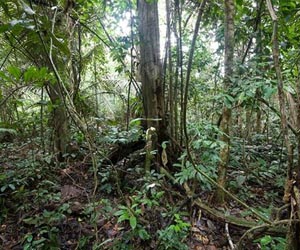| . |  |
. |
St. Lois MO (SPX) Jul 13, 2010 As the mercury rises outdoors, it's a fitting time to consider the effects of summertime droughts and global warming on ecosystems. Complex interactions among temperature, water cycling, and plant communities create a tangled web of questions that need to be answered as we face a rapidly changing climate. Drs. Emily Limm and Todd Dawson (University of California, Berkeley) recently tackled one aspect of the challenging question of how climate change can impact plant communities that obtain water from fog. Their results are published in the July issue of the American Journal of Botany. Fog is an important source of water to ecosystems around the world, because fog allows plants to stay hydrated even during times without rain. Fog may condense and drip to the soil, where it can be taken up by roots. Alternatively, some plants are able to absorb the water from fog through their leaves, allowing these plants to immediately benefit from the atmospheric moisture that may never reach the forest floor. The fern Polystichum munitum covers the forest floors of the redwood forests in northern California. Limm and Dawson examined variation in the ability of the leaves of P. munitum to absorb the water from fog. The researchers found that the quantity of water the plants absorbed varied in the different regions of the redwood forest. "Today, summertime drought conditions are greater in the southern end of the redwood forest ecosystem of Northern California, and this reduces P. munitum abundance and plant size. These smaller ferns in the south are less able to capture fog water that drips to the forest floor during the summer, and they may therefore suffer more drought stress than ferns in the northern end of the redwood forest ecosystem," Limm stated. This has important implications for the structure of plant communities. Limm explained, "If climate change causes further shrinkage of these ferns, this will change how fog water is distributed on the forest floor and may lead to dramatic changes in how the redwood understory functions." Limm and Dawson are hoping that native ferns may be able to acclimate to increasing drought conditions, and this acclimation would allow the plants to mitigate the effects of drought on the ecosystem and reduce the potential for local population extinctions. "If these ferns can make morphological and physiological adjustments to survive when drought intensifies, then they will be less impacted by climate change in the near future," Limm commented. Limm and Dawson have involved the public in their research through a Citizen Scientist program. The public helps to collect data on the abundance of P. munitum in a redwood forest near Oakland, California. This not only has contributed to the research on the effect of climate change on P. munitum, but also has resulted in a change in people's impressions of the forest. "I've often heard people exclaim that they never realized that there where even plants on the forest floor in the redwood forest because they are always looking up at the giant coast redwoods...After they learn about P. munitum's amazing ability to absorb fog water through their leaves in much higher rates than the coast redwood, they often tell me that they will never look at a fern the same way again," Limm said.
Share This Article With Planet Earth
Related Links American Journal of Botany Forestry News - Global and Local News, Science and Application
 Storm may have killed half a billion trees
Storm may have killed half a billion treesWashington (UPI) Jul 12, 2010 A violent storm that swept through Brazil's Amazon rain forest in 2005 may have killed half a billion trees in just two days, a new study says. Storms have been understood as one cause of Amazon tree loss, but a new study funded by NASA and Tulane University says the losses are much greater than previously suspected, a release by the American Geophysical Union said Monday. A peak ... read more |
|
| The content herein, unless otherwise known to be public domain, are Copyright 1995-2010 - SpaceDaily. AFP and UPI Wire Stories are copyright Agence France-Presse and United Press International. ESA Portal Reports are copyright European Space Agency. All NASA sourced material is public domain. Additional copyrights may apply in whole or part to other bona fide parties. Advertising does not imply endorsement,agreement or approval of any opinions, statements or information provided by SpaceDaily on any Web page published or hosted by SpaceDaily. Privacy Statement |